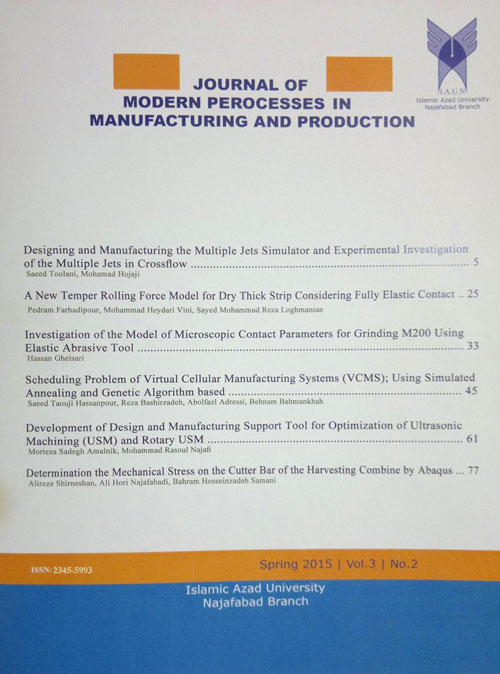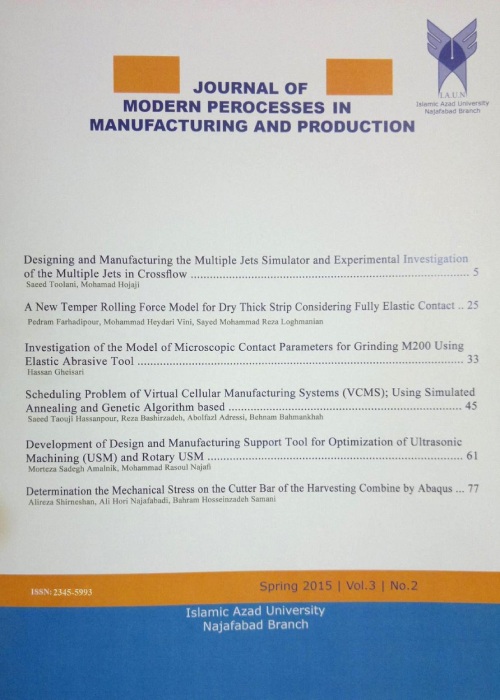فهرست مطالب

Journal of Modern Processes in Manufacturing and Production
Volume:6 Issue: 4, Autumn 2017
- تاریخ انتشار: 1396/10/30
- تعداد عناوین: 7
-
Pages 5-22In this paper, a task-space controller for electrically driven robot manipulators is developed using a robust control algorithm. The controller is designed using voltage control strategy. Based on the nominal model of the robotic arm, the desired signals for motor currents are calculated and then the voltage control law is proposed based on the current errors and motor nominal electrical model. Uncertainties such as parametric uncertainties, external disturbances and also imperfect transformation are compensated in the control law. The case study is a two-link robot manipulator equipped by permanent magnet DC motors. Simulation results verify the satisfactory performance of the proposed controller in reducing the tracking error and overcoming uncertainties.Keywords: Robust Task, space control, Imperfect transformation, Uncertain kinematics, Uncertain dynamics
-
Pages 23-33In this research, finite element analysis of the conventional drilling and vibration assisted drilling is carried out. The ABAQUS software is employed for FE analysis. The Johnson-Cook models for both plastic deformation and damage are employed for FE simulation.The results of the FE analysis are then verified with experimental results in both conventional and vibration assisted drilling on Al 7075 with HSS drill in terms of the drilling axial force and torsional torque. There is a good agreement between the experimental results and the FE simulation results. The results also show that the drilling axial force and torsional torque are reduced in vibration assisted drilling in comparison with that in conventional drilling process. The surface roughness of the holes is also studied in conventional drilling and vibration assisted drilling. The results showed that the surface roughness is exceled in vibration assisted machining in comparison with that in conventional drilling.Keywords: FE Analysis, Vibration Assisted Drilling, Conventional Drilling, Experiment, Al7075
-
Pages 35-46The widespread application of thermoplastic polymers in different aspects of industries has motivated researchers and companies to improve and upgrade their forming, joining and assembling processes to overcome their limitations. One of the newest joining methods of thermoplastics is friction stir welding which is based on frictional heat generated through contact between a rotating tool and the workpiece.The aim of this study is to investigate the weldability of dissimilarpoly methyl methacrylate and polycarbonatesheets via friction stir welding approach.The effects of process parameters such as rotational and traverse speeds and the heater temperature on the mechanical properties of the joints were studied comprehensively. Rotational and traverse speeds and heater temperature of 2100 rpm, 8 mm/min and 120 °C, offered the optimized mechanical properties of the joint. In the optimum joining condition, welded joint with strength equal to 98% of polycarbonate and with higher hardness than the polycarbonate was obtained.Keywords: Thermoplastic Polymer, Poly Methyl Methacrylate, Polycarbonate, Heat Assisted Friction Stir Welding
-
Pages 47-58A properly designed machining procedure can significantly affect the efficiency of the production lines. To minimize the cost of machining process as well as increasing the quality of products, cutting parameters must permit the reduction of cutting time and cost to the lowest possible levels. To achieve this, cutting parameters must be kept in the optimal range. This is a non-linear optimization with constrains and it is difficult for the conventional optimization algorithms to solve this problem. This paper presents Colonial Competitive Algorithm (CCA) approach to determine the optimal cutting parameters required to minimize the cutting time while maintaining an acceptable quality level.CCA is inspired by competition mechanism among imperialists and colonies, in contrast to evolutionary algorithms that perform the exploration and exploitation in the solution space aiming to efficiently find near optimal solutions using a finite sequence of instructions. Therefore, a case study from literature was considered and optimized using of CCA. To validate the proposed approach, the results of CCA were finally compared with the Genetic Algorithm (GA). Based on the results, CCA has demonstrated excellent capabilities such as accuracy, faster convergence and better global optimum achievement.Keywords: Optimization, Cutting process, Colonial Competitive Algorithm
-
Pages 59-68The hydrostatic extrusion is a new method of extrusion process. The most important advantage of this method is reduction of friction and close tolerance for the coating thickness. In this study, the hydrostatic extrusion simulation of bimetallic wires has performed using of finite element method. In the following the advantages of hydrostatic extrusion compared to the direct extrusion are presented.It can be concluded that by increasing the friction coefficient between the work piece and the die, the extrusion force value also increases. Increasing the cross-section reduction when the die angle kept constant as a result of increase in die length, consequently leads to an increase in the extrusion force.Regarding to the absence of friction in the die and almost uniformly deformation and homogeneous in the hydrostatic extrusion, the product with a uniform coating thickness can be obtained as it is very important for manufacture of very high length bi-metal products.Keywords: Hydrostatic Extrusion, Bimetallic Wire, Finite element method
-
Pages 69-79Nowadays, with the presence of technology in the human life, organizational levels have received a lot of changes which affected the operational aspects and the organizational structures from traditional to modern. Therefore, this study investigated the role of technology management to predict operational performance as the most important sources for gaining competitive advantages. It aimed to identify the indicators and investigate the relationship between technology management and operational performance. Two researcher-made questionnaires were used in order to assess operational performance and technology management. These questionnaires have been allocated to the experts of the company which produces utility gas meters. Data analysis was performed using Pearson correlation and One Sample T-Test with the Amos software. The research findings showed that technology management has the power to predict the operating performance of the company. It means the improvement in technology management leads to better and higher operational performance.Keywords: Technology Management, Operational Performance, Manufacturing, Utility Gas Meters
-
Pages 81-98In this research, the effects of parameters include tool rotational and traverse speeds were investigated on heat generation and material flow during friction stir welding of Ti-6Al-4V alloy with computational fluid dynamics (CFD) method. Simulation results showed that with increasing of tool rotational and decreasing tool traverse speed, the more frictional heat generates which causes formation of bigger stir zone. Results indicate that the rotation of the shoulder can accelerate the material flow behavior near the top surface. The temperature field in the friction stir welding of Ti-6Al-4V alloy was anti symmetric to the welding line. Due to the results the heat generation and temperature distribution at advancing side were more than retreating side in all joint conditions. According to the results unsmooth and disarray flow patterns were formed in stir zone which caused formation of banded layer structure in advancing side. Due to results the torque decreases with an increase in the tool rotation speed due to increases in the heat generation rate and temperature, but torque is not significantly affected by the change in welding speed. The computed pressure field was higher in front of the tool compared to the trailing edge, and it is because pressure difference is required for flow occur. According to the selected parameters in this study, maximum temperature was produced in 800rpm tool speed and the computed strain rate and pressure of workpiece in this speed were 2.3 s-1, 0635 MPa, respectively.Keywords: Friction Stir Welding, Ti, 6Al, 4V Titanium Alloy, Computational Fluid Dynamic, Thermal Modeling


